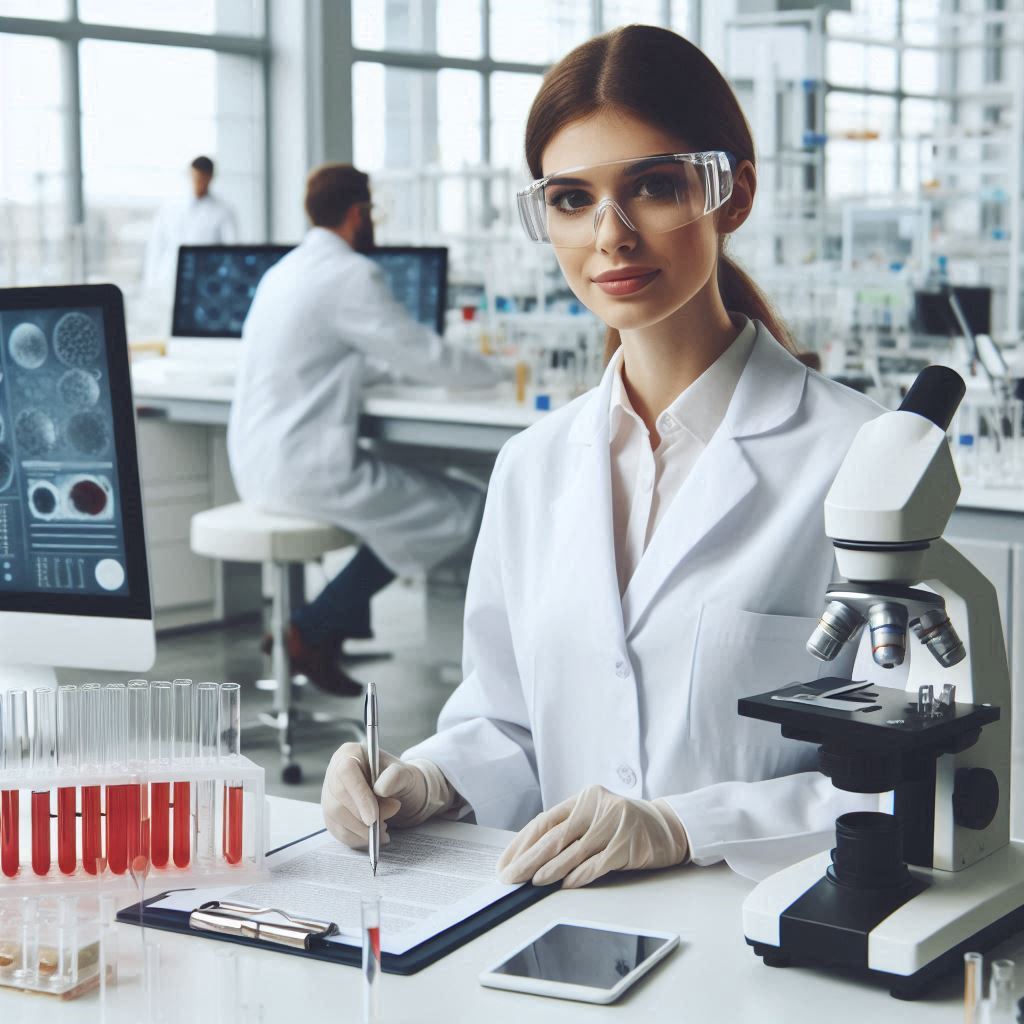Introduction
Biomedical engineering merges engineering principles with medical sciences to create cutting-edge medical devices that significantly enhance patient care.
In the medical device field, biomedical engineers are at the forefront of developing technologies such as prosthetics, imaging systems, and diagnostic tools.
These innovations are crucial for diagnosing, monitoring, and treating various health conditions.
Biomedical engineers contribute to healthcare by improving device functionality, safety, and effectiveness.
Their work ensures that medical devices not only meet stringent safety standards but also address complex medical challenges.
The integration of advanced technologies and engineering solutions enables the creation of more accurate, reliable, and efficient devices.
The purpose of this blog post is to delve into the essential role of biomedical engineering within the medical device sector.
We will explore how these technological advancements transform patient care and the significant impact engineers have on the development and refinement of medical devices.
Overview of Biomedical Engineering
Definition and Scope of Biomedical Engineering
Biomedical engineering combines engineering principles with medical and biological sciences.
It focuses on developing technologies that improve healthcare outcomes.
This field encompasses a wide range of activities, including designing medical devices, creating diagnostic tools, and developing new treatment methods.
Biomedical engineers work on innovations such as prosthetics, imaging systems, and wearable health monitors.
They use their expertise to bridge the gap between engineering and medicine, applying engineering techniques to solve complex medical problems.
Role of Biomedical Engineers in Developing Medical Devices
Biomedical engineers play a crucial role in the development of medical devices.
They are involved in various stages of device creation, from conceptual design to final implementation.
Their responsibilities include:
- Designing and Prototyping: Engineers create initial designs and prototypes of medical devices, ensuring they meet clinical needs.
- Testing and Validation: They conduct rigorous testing to validate the functionality, safety, and efficacy of medical devices.
- Regulatory Compliance: Engineers ensure that devices adhere to regulatory standards and guidelines, facilitating approval and market entry.
- Innovation and Improvement: They continuously seek ways to enhance existing devices or develop new technologies to address emerging medical challenges.
Biomedical engineers work closely with healthcare professionals to understand the clinical requirements and challenges.
Their goal is to develop devices that are not only technically advanced but also practical and effective for patient care.
Importance of Integrating Engineering Principles with Medical Knowledge
Integrating engineering principles with medical knowledge is essential in biomedical engineering.
This interdisciplinary approach ensures that medical devices are both innovative and applicable to real-world clinical scenarios. Key aspects include:
- Enhanced Problem-Solving: Combining engineering and medical expertise allows for more effective solutions to complex health issues.
- Improved Device Functionality: Engineers use their technical skills to design devices that perform optimally and meet medical standards.
- Informed Design Choices: Medical knowledge helps engineers make design choices that align with patient needs and clinical practices.
- Increased Collaboration: Collaboration between engineers and medical professionals leads to more comprehensive and effective device development.
Integrating these disciplines ensures that biomedical engineering solutions are not only technologically advanced but also address the practical needs of patients and healthcare providers.
This synergy is crucial for developing medical devices that improve patient outcomes and advance the field of healthcare.
By leveraging both engineering and medical insights, biomedical engineers drive innovation and enhance the quality of care through sophisticated, effective medical technologies.
Read: CAD Technician vs. Draftsman: Key Differences
Importance of medical devices in healthcare
Medical devices play a crucial role in the delivery of healthcare services, significantly impacting patient care and overall health management.
These devices are essential tools for diagnosing, monitoring, and treating various health conditions, making them indispensable in modern medicine.
They assist healthcare professionals by providing critical information about a patient’s condition.
With accurate data from medical devices, clinicians can make precise diagnoses and develop effective treatment plans tailored to individual patient needs.
This capability leads to better-targeted interventions and improves patient outcomes.
In addition to diagnostic and treatment applications, medical devices are instrumental in managing chronic conditions.
Devices such as glucose monitors, blood pressure cuffs, and wearable health trackers allow patients to continuously monitor their health at home.
This real-time data empowers patients to make informed decisions about their care, adjust their lifestyle, and adhere to treatment protocols more effectively.
Furthermore, medical devices enhance the quality of life for patients by offering improved management of health conditions.
They facilitate early detection of issues, prompt intervention, and ongoing support, which are crucial for managing complex and long-term health challenges.
Overall, medical devices are vital for advancing healthcare by improving diagnostic accuracy, treatment efficacy, and patient self-management.
Their integration into everyday medical practice not only supports healthcare professionals but also empowers patients to take an active role in their own health.
How medical devices contribute to diagnosis and treatment of diseases
Medical devices are pivotal in diagnosing and treating diseases, providing essential tools that enhance the accuracy and effectiveness of medical care.
Devices like MRI machines, X-ray machines, and blood glucose monitors are integral to modern healthcare.
MRI machines offer detailed images of internal organs and tissues, helping healthcare professionals diagnose conditions such as tumors, brain disorders, and spinal injuries.
X-ray machines provide critical images of bones and other structures, enabling the detection of fractures, infections, and abnormalities.
Blood glucose monitors are vital for managing diabetes.
They allow patients to track their blood sugar levels regularly, helping to prevent complications and manage their condition effectively.
In emergencies, devices like defibrillators are crucial.
They can restore normal heart rhythms during cardiac arrest, significantly improving patient survival rates.
Similarly, other devices such as pacemakers and ventilators play essential roles in stabilizing and treating patients with heart and respiratory conditions.
Overall, medical devices contribute significantly to diagnosing diseases accurately and providing timely, effective treatment.
They empower healthcare professionals with the tools needed to make informed decisions, ultimately improving patient outcomes and enhancing the quality of care.
Examples of common medical devices used in various medical fields
- Pacemakers are commonly used in cardiology to regulate heart rhythm.
- MRI machines are frequently used in neurology to diagnose brain and spinal cord injuries.
- Infusion pumps are essential in oncology for delivering chemotherapy drugs.
- Joint implants are commonly used in orthopedics to replace damaged joints.
Impact of medical devices on patient outcomes and quality of life
Medical devices profoundly impact patient outcomes and quality of life by facilitating timely and accurate diagnosis, effective treatment, and ongoing monitoring of health conditions.
By enabling precise and early diagnosis, medical devices help healthcare professionals detect diseases in their initial stages.
This early detection often leads to more effective treatment options and improves overall patient outcomes.
Devices such as MRI machines and blood tests provide critical data that guide treatment plans and interventions.
Patients with access to appropriate medical devices experience significant improvements in their quality of life.
For example, those with chronic conditions benefit from devices that allow for regular monitoring and management.
Diabetic patients use glucose monitors to track their blood sugar levels, adjust insulin dosages, and manage their condition more effectively.
This leads to better control of their diabetes and reduces the risk of complications.
Devices such as pacemakers, hearing aids, and prosthetics enhance daily functioning and comfort.
Pacemakers help regulate heart rhythms, hearing aids improve auditory function, and prosthetics restore mobility and independence.
Each of these devices contributes to a higher quality of life by addressing specific health challenges and enabling patients to lead more active and fulfilling lives.
Medical devices play a crucial role in improving patient outcomes and enhancing the quality of life.
They provide the tools needed for effective disease management, reducing complications, and promoting better health and well-being.
Read: Ultrasound Technician vs. Radiologic Technologist
Trends in the medical device industry
The field of biomedical engineering in the medical device industry is constantly evolving, with new trends and advancements shaping the future of healthcare.
Understanding these trends is crucial for engineers, researchers, and developers to stay ahead and contribute to the growth of this dynamic field.
Advancements in technology driving innovation in medical devices
Technological advancements such as artificial intelligence, machine learning, and Internet of Things (IoT) have revolutionized the medical device industry.
These innovations have enabled the development of smart devices that can monitor patients in real-time, analyze data, and provide personalized healthcare solutions.
With the rise of wearable technology and connected devices, engineers are now able to create more efficient and accurate medical devices that improve patient outcomes.
Regulatory challenges and requirements for medical device development
As the medical device industry expands, engineers and developers face increasingly complex regulatory challenges and requirements.
The landscape of medical device regulation involves navigating a myriad of standards and guidelines set by regulatory bodies like the Food and Drug Administration (FDA) and other international authorities.
Engineers and developers must comply with rigorous guidelines to ensure the safety and efficacy of medical devices.
These guidelines cover every stage of development, from initial design to post-market surveillance.
They ensure that devices meet high standards of performance and safety before they can be approved for use.
Regulatory bodies require comprehensive testing and documentation to demonstrate that a medical device performs as intended and does not pose undue risk to patients.
This includes preclinical studies, clinical trials, and detailed reporting of results.
Ensuring the safety and efficacy of devices is crucial for gaining regulatory approval and protecting patient health.
Navigating these regulations can be challenging due to the detailed requirements and the need for extensive documentation.
Engineers must stay current with evolving standards and guidelines, which can vary by country and region.
Additionally, the process can be time-consuming and costly, impacting the development timeline and budget.
Compliance with regulatory requirements is essential for bringing new medical devices to market.
It impacts the speed at which innovations can be introduced and requires careful planning to meet all necessary criteria.
Failure to comply can result in delays, additional costs, or denial of market approval.
Overall, understanding and adhering to regulatory challenges and requirements is a fundamental aspect of medical device development.
Ensuring compliance helps protect patient health, facilitates successful product launches, and supports the ongoing advancement of medical technology.
Emerging areas of research in biomedical engineering for medical devices
Research in biomedical engineering is focused on developing innovative solutions to address the growing needs of the healthcare industry.
Areas such as nanotechnology, bioinformatics, and tissue engineering are gaining prominence as researchers explore new ways to improve diagnosis, treatment, and patient care.
By integrating these cutting-edge technologies into medical devices, engineers can create more advanced and effective solutions that enhance the quality of healthcare for patients worldwide.
The field of biomedical engineering in the medical device industry is at the forefront of innovation and growth.
By keeping abreast of current trends, advancements in technology, regulatory challenges, and emerging research areas, engineers and developers can contribute to the development of life-changing medical devices that improve the health and well-being of people around the world.
Read: Surgical Technologist Job Outlook: Demand and Opportunities

Role of biomedical engineers in the medical device field
Biomedical engineers play a crucial role in the development and advancement of medical devices.
They integrate engineering principles with medical and biological sciences to create innovative solutions that enhance patient care and treatment outcomes.
These professionals are involved in every stage of medical device development, from conceptual design to clinical implementation.
They work closely with healthcare providers to understand clinical needs and translate them into functional devices.
Their expertise ensures that medical devices are not only effective but also safe for patients.
By continuously researching and applying new technologies, biomedical engineers drive improvements in diagnostic tools, therapeutic devices, and monitoring systems, ultimately contributing to better healthcare delivery and improved patient quality of life.
Responsibilities of biomedical engineers in designing and testing medical devices
- Conceptualize and design prototypes of medical devices to address specific clinical needs.
- Conduct feasibility studies and market research to assess the potential success of a new device.
- Collaborate with cross-functional teams, including clinicians and researchers, to gather input and feedback.
- Use computer-aided design (CAD) software to create detailed plans and models for manufacturing.
- Perform testing and validation of prototypes to ensure safety, efficacy, and compliance with regulations.
Collaboration with healthcare professionals to meet clinical needs
- Work closely with physicians, surgeons, and other healthcare professionals to understand the challenges they face.
- Participate in rounds and observation sessions in clinical settings to gain insights into patient care practices.
- Seek input and feedback from end-users to iteratively refine the design of medical devices.
- Present prototypes and solutions to medical teams for evaluation and validation in real-world scenarios.
- Engage in continuous learning and professional development to stay current with medical advancements and best practices.
Ensuring safety and effectiveness of medical devices through rigorous testing and validation
- Adhere to regulatory standards and guidelines, such as FDA regulations, throughout the design and development process.
- Perform biocompatibility tests to ensure that materials used in medical devices are safe for patient use.
- Conduct performance testing to assess the functionality and reliability of the device under various conditions.
- Implement risk management strategies to identify and mitigate potential hazards associated with the device.
- Document all testing procedures and results in a comprehensive report for regulatory submissions and audits.
Most importantly, biomedical engineers play a vital role in the medical device field by driving innovation, collaborating with healthcare professionals, and ensuring the safety and effectiveness of new technologies.
Their multidisciplinary approach and attention to detail make them indispensable in creating transformative solutions that positively impact patient care.
Read: Interview Tips for Landing a Surgical Technologist Job
Challenges in Biomedical Engineering for Medical Devices
- Balancing cost-effectiveness with quality and innovation
- Adapting to changing regulatory landscape
- Meeting market demands
- Ensuring patient safety
- Maintaining transparency and integrity
- Addressing environmental impact
Addressing Ethical Considerations in Medical Device Development
Addressing ethical considerations in medical device development involves careful attention to several critical factors.
Biomedical engineers must ensure patient safety by rigorously testing devices to prevent harm and address potential risks.
They must respect patient autonomy, ensuring that patients have the necessary information to make informed decisions about their care.
Maintaining confidentiality is crucial, as engineers handle sensitive patient data during device development and testing.
One significant ethical dilemma is balancing the benefits of a device with potential risks to patients.
Engineers must navigate complex trade-offs, ensuring that the advantages of using a device outweigh any possible negative outcomes.
They must also consider long-term impacts, including potential side effects and the device’s overall effect on patient well-being.
By addressing these ethical considerations thoughtfully, engineers can develop devices that uphold high standards of safety, efficacy, and respect for patient rights.
Transform Your Career Today
Unlock a personalized career strategy that drives real results. Get tailored advice and a roadmap designed just for you.
Start NowBalancing Cost-effectiveness with Quality and Innovation
Balancing cost-effectiveness with quality and innovation poses a significant challenge in biomedical engineering.
Engineers must ensure that medical devices are affordable without sacrificing their quality or innovative features.
Achieving this balance involves optimizing the manufacturing process, finding efficient material sources, and streamlining production methods.
While creating cost-effective devices is crucial for making healthcare accessible, it is essential that cost reductions do not undermine the device’s effectiveness or safety.
Engineers should continuously explore ways to enhance production efficiency and reduce costs while maintaining high standards of quality.
This involves leveraging advanced technologies, implementing rigorous quality control measures, and ensuring that every aspect of the device—from design to final production—meets the required standards.
Ultimately, the goal is to deliver devices that are both economical and of high quality, ensuring that innovation and patient care remain at the forefront of biomedical engineering efforts.
Adapting to Changing Regulatory Landscape and Market Demands
The regulatory landscape governing medical devices is constantly evolving, with new guidelines and standards being introduced regularly.
Biomedical engineers must stay updated on these changes to ensure their devices meet regulatory requirements.
Moreover, market demands are ever-changing, with consumers and healthcare providers seeking advanced, user-friendly, and cost-effective medical devices.
Engineers need to adapt to these demands while also meeting regulatory compliance to stay competitive in the market.
Biomedical engineering in the medical device field presents unique challenges that require careful consideration and innovative solutions.
Read: Continuing Education for Surgical Technologists: Why It Matters
Case studies of successful medical devices developed by biomedical engineers
Innovative Medical Devices That Have Made Significant Impact in Healthcare
Biomedical engineers have revolutionized healthcare with several groundbreaking medical devices.
These innovations not only enhance patient care but also demonstrate the impact of engineering ingenuity.
One notable example is the Cochlear Implant.
This device restores hearing for individuals with severe hearing loss.
It bypasses damaged parts of the ear, directly stimulating the auditory nerve.
The cochlear implant has transformed the lives of thousands, allowing them to hear and communicate effectively.
Biomedical engineers involved in its development include Dr.
Graeme Clark, whose pioneering work led to its creation.
The implant’s success lies in its advanced sound processing technology and precise electrical stimulation.
Another significant advancement is the Insulin Pump.
This device provides continuous insulin delivery for diabetes management, replacing the need for multiple daily injections.
It helps maintain blood glucose levels within a target range, reducing the risk of complications.
Biomedical engineers developed the insulin pump with features such as programmable delivery rates and real-time glucose monitoring.
The collaboration of engineers like Dean Kamen, who also invented the device, showcases the critical role of engineering in improving diabetes care.
Key Features and Benefits of These Devices
One notable example is the Cochlear Implant.
This device restores hearing for individuals with severe hearing loss.
It bypasses damaged parts of the ear, directly stimulating the auditory nerve.
The cochlear implant has transformed the lives of thousands, allowing them to hear and communicate effectively.
The key features include advanced sound processing technology and precise electrical stimulation, which have made it a vital tool for hearing restoration.
Another significant advancement is the Insulin Pump.
This device provides continuous insulin delivery for diabetes management, replacing the need for multiple daily injections.
It helps maintain blood glucose levels within a target range, reducing the risk of complications.
Key features include programmable delivery rates and real-time glucose monitoring, which contribute to better diabetes control and improved quality of life.
Share Success Stories of Biomedical Engineers Involved in Their Development
Biomedical engineers played a crucial role in developing these devices.
For the cochlear implant, Dr. Graeme Clark’s pioneering work led to its creation, transforming the field of auditory technology.
Dean Kamen’s collaboration resulted in the development of the insulin pump, which has significantly improved diabetes care.
The Robotic Surgical Systems, like the da Vinci Surgical System, represent a major leap forward in minimally invasive surgery.
These systems allow surgeons to perform complex procedures with enhanced precision and control.
Biomedical engineers involved in this project, including Dr. Frederic Moll, integrated high-definition 3D visualization and precise robotic movements, drastically improving surgical outcomes and reducing recovery times.
Wearable Health Monitors track various health metrics such as heart rate, blood pressure, and physical activity.
They provide real-time data, assisting in the management of chronic conditions.
Engineers designed these monitors with features like wireless data transmission and user-friendly interfaces.
Devices like Fitbit and Apple Watch exemplify the success of these innovations in personal health management.
Prosthetic Limbs have also seen remarkable advancements.
Modern prosthetics, incorporating advanced materials and control systems, offer improved mobility and dexterity.
Engineers like Hugh Herr have pioneered designs that closely mimic natural limb movement, enhancing the user’s quality of life.
These case studies highlight the profound impact of biomedical engineering on healthcare.
Each device represents the culmination of engineering expertise, innovation, and dedication to improving patient outcomes.
Biomedical engineers continue to push the boundaries of technology, creating solutions that transform lives and advance medical care.
Conclusion
Biomedical engineering plays a crucial role in the medical device field, driving innovation and improving healthcare outcomes.
The development and implementation of advanced medical devices have transformed patient care, enabling more precise diagnostics, effective treatments, and improved patient quality of life.
Aspiring biomedical engineers should consider careers in medical device development, where they can significantly impact healthcare by creating cutting-edge technologies that address pressing medical needs.
Biomedical engineering offers exciting opportunities to work on groundbreaking projects, from designing life-saving implants to developing advanced imaging systems.
By pursuing this path, engineers can contribute to innovations that enhance medical treatments and patient outcomes.
Staying updated on the latest advancements in biomedical engineering and medical devices is essential for professionals and enthusiasts alike.
It ensures they remain informed about new technologies, breakthroughs, and emerging trends, fostering continuous learning and professional growth.
Readers are encouraged to follow developments in this dynamic field to understand its evolving impact on healthcare.
This engagement can inspire new ideas, drive innovation, and promote a deeper appreciation for the vital role of biomedical engineers.
Staying informed also helps identify opportunities for collaboration and investment in promising technologies.
In summary, biomedical engineering is vital to healthcare innovation, offering numerous opportunities for those passionate about making a difference.
Aspiring biomedical engineers should embrace the challenges and rewards of medical device development, knowing their work can improve lives and advance medical science.
Stay informed, stay inspired, and contribute to the future of medical technology by actively participating in this transformative field.
Your efforts can lead to significant advancements that shape the future of healthcare and benefit society as a whole.
[E-Books for Sale]
The Big Book of 500 High-Paying Jobs in America: Unlock Your Earning Potential
$19.99 • 500 High-Paying Jobs • 330 pages
Explore 500 high-paying jobs in America and learn how to boost your career, earn more, and achieve success!
See All 500 High-Paying Jobs of this E-Book
1001 Professions Without a Degree: High-Paying American Jobs You Can Start Now
$19.99 • 1001 Professions Without a Degree • 174 pages
Discover 1001 high-paying jobs without a degree! Unlock career tips, skills, and success strategies for just $19.99!




